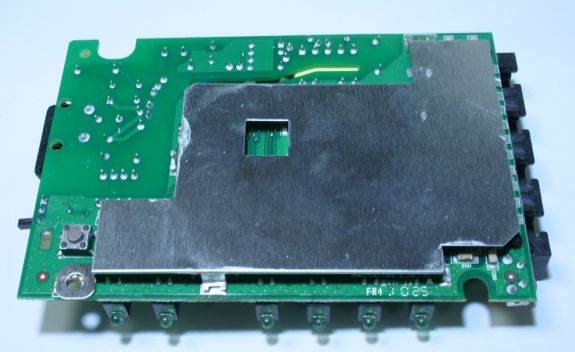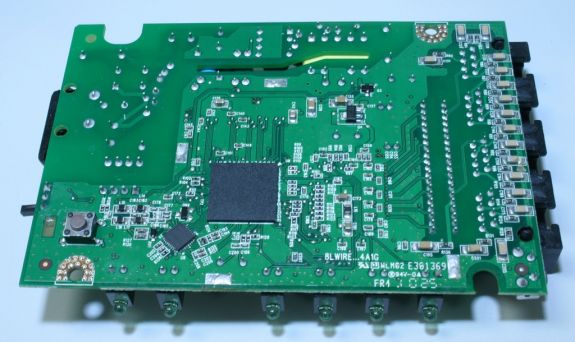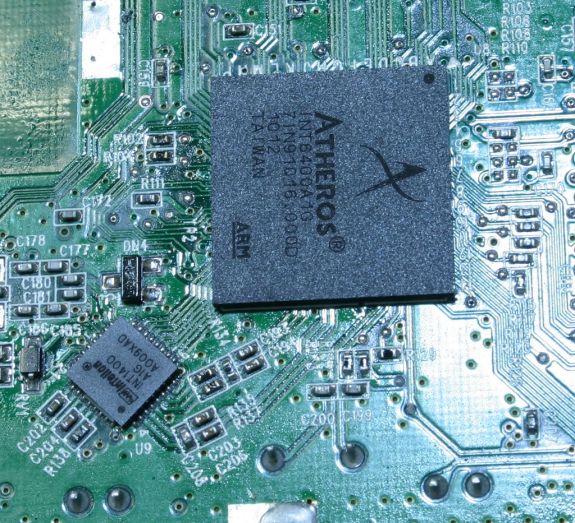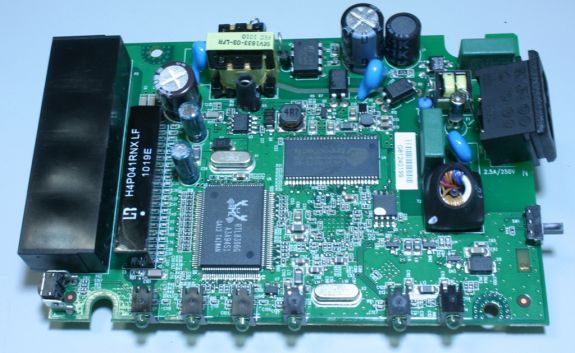Powerline Networking with the Western Digital Livewire
by Ganesh T S on August 24, 2010 7:50 AM EST- Posted in
- Gadgets
- Networking
- Powerline Adapters
At AnandTech, we are always interested in getting to know what actually powers the units we review. The WD Livewire happens to be the first powerline adapter product that we are reviewing. Though we had heard about Atheros/Intellon and Gigle Networks before, it is always exciting to open up one of the kits and confirm the chips ourselves. One of the routing units was given the teardown treatment, and the results are presented below for your viewing pleasure.
The routing unit appears quite impregnable, until one realizes that two out of the four circular gripping pads at the bottom of the unit hide screws beneath them. Once these were out of the way, disassembling was fairly straightforward. Removing the bottom plastic plate revealed a thin metal film covering the PCB. The intent of this metal film is to act as a shield for the heat generated by the chip behind and prevent it from possibly melting the underside of the unit. The metal film is held in place by two screws and is also soldered to the PCB.

Metal Film for Thermal Protection
After unscrewing and unsoldering the metal film, we are presented with the underside of the PCB, which contains the main chips enabling the powerline networking functionality. Our suspicions are confirmed, with the Atheros INT6400 chip, as well as the Intellon AFE (Analog Front End), INT1400 (PDF) making an appearance.

The Underside is Largely Unpopulated Except for the Powerline Chips

Up Close with the Powerline Chips
With a little bit of maneuvering, it is also possible to completely remove the PCB from the casing (as we have already done in this section's pictures). The top portion of the PCB shows a transformer, multiple capacitors and the Realtek RTL8306G 6 port Fast Ethernet switch controller. EtronTech supplies the DRAM for the chipset, and is the other big chip which can be seen in the photograph.
So, we have taken a look at the internals of the WD Livewire. In the next section, we will look at how it performs.











31 Comments
View All Comments
BubbaJoe TBoneMalone - Tuesday, August 24, 2010 - link
I use a USB stick to transfer video content from from my computer to my HD TV via the WD TV Live HD Media Player. I love this but will wait for the upcoming Atheros AR7400 chipset and its testing of 1080p content at AnandTech. :)glugglug - Tuesday, August 24, 2010 - link
Installing ethernet wiring is much cheaper than this, particularly when for the lengths you will want to run it through the home, likely going through walls, you will end up making your own cables.I bought 500ft of CAT5e, along with a bag of end connectors and a crimping tool all together for $35 off e-bay. It was not difficult to find the pin-outs needed online and crimp my own cables.
I needed the performance and reliability of wired ethernet rather than wired because I am using it with Media Center Extenders to stream TV throughout the apartment.
In applications like this that require good performance and have more than 2 nodes, powerline networking is not a fit because it acts like a hub rather than a switch - so there will be network collisions - and yet it costs more. If you don't need the peformance, wireless is more convenient. So that basically leaves no situations in which powerline networking is the correct solution.
dijuremo - Tuesday, August 24, 2010 - link
You are missing the point that not everyone want/can run cat5/cat6 on their homes. Not everyone has the expertise or time to go through sheet rock, fish cables, etc, specially if you are going between floors in a 2 or more story home. The product is aimed to those people, not the tech savy guy who is not afraid of cutting sheet rock, pulling wire and crimping it.For a regular person, it would be easy to plug the device to the power lines in two locations and that is it, they are done, no sheet rock cutting and patching, dealing with fiber insulation, fishing wire, etc. Is it the best way? No, Is it the easiest way? Yes.
mmatis - Wednesday, August 25, 2010 - link
Or what about anyone who is renting their home? Do you think the owner is gonna want them pulling cable? Not that ANYONE is renting these days with the outstanding real estate market that we are currently in...BPB - Tuesday, August 24, 2010 - link
What about a home built in the late 60's or earlier that is two stories high? One not built with the intent of being re-wired, so there are many obstacles. It's for reasons like this that people consider "wireless" options. I'd love to wire my place with ethernet cable, but it just isn't worth the hassle.Dravic - Tuesday, August 24, 2010 - link
Time was a factor for myself...I have plenty of CAT cable for the job, and have built many cables in my time as a network admin. With a full time job, 3 kids, and learning android programming.. I neither had the time or will to patch and paint after running cables in my home. An contractors tend to do a crappy job, or a "good enough" job.
I have 2 netgear powerline 200Mbps adapters connecting my main floor with my office upstairs (delivers all 25/25 of my FIOS easily). I attempted a 3rd adapter in the basement with the 360, HD tv, and slingbox but with too many serial power drops i couldnt get a reliable signal. So i went with a pair of netgear MOCA land bridges from the basement to the main floor over coax.
After years of dealing with crappy Wireless WDS solutions(speed halved, only WEP in wds, resets) , the Powerline adapters and MoCA bridges have given man "wired" conenctions from the 2nd floor to the basement. Now i can stream my sling box at its highest setting, and im wire speed for 360 (games and netflix).
~$300 (powerline kit and moca bridge kit), so its a bit pricey, but its done, works, and i didn't have to patch and paint any more then i already do with a wife and 3 kids...
knight511 - Tuesday, August 24, 2010 - link
It is easy to fail to see the benefits of powerline networking when you live in an apartment. Once you are in a house and you are trying to set up your entertainment system and your network, you will look at 500ft of cat 5 and think "Isn't that cute." Powerline networking has been of interest to me (and I am sure I am not the only one) because my entertainment system in my living room is on an exterior wall of the house. It is much more difficult to run ethernet cable to an exterior wall (especially in a room with a vaulted ceiling which limits the crawl space in the attic) unless you are okay with the eye sore of cable being run down the outside wall of your house. I have gone through great lengths to have only a single cable (RG6 for my cable) on the exterior of my house (and I am talking a run of less than 15 feet as it exits the attic at the soffit and runs down and through the wall to the TV location)... the last thing I want is a bunch of cat-5 run around the exterior of my house.Unfortunately, this product doesn't look like the answer I was searching for either... it looks like a day or so in the attic getting the cat-5 dropped "close enough" to the entertainment center still lays in my future. :-)
chromatix - Tuesday, August 24, 2010 - link
...amateur radio operators nearby may wind up being interfered with - where "nearby" could be miles away. They don't like that, and the more proactive ones might track down your house as the source of it and put a polite note through the door telling you about it.The problem is quite fundamental - in order to get that kind of data bandwidth through a wire, it is necessary to use a lot of signal bandwidth - and that means you are sending high-frequency wide-bandwidth signals through wires designed to carry only 50Hz. These wires then radiate a lot of this energy into the surroundings, and despite notches having been cut in the spectrum for this purpose, some of that energy is in the bands that radio operators are trying to listen for weak signals on.
Ethernet, being made of twisted pairs, is designed to not radiate the signals transmitted through it. This is also why Cat6, with more twists in it, is preferred for GigE.
ganeshts - Tuesday, August 24, 2010 - link
chromatix,Do you have any documented cases of this happening? I believe the HomePlug AV standards make sure that the operating frequency bands do not interfere with spectrum already in use.
Thanks.
chromatix - Tuesday, August 24, 2010 - link
From http://en.wikipedia.org/wiki/Power_line_communicat..."The British communications regulator Ofcom has investigated a number of PLT-related complaints but nearly 20% of these remain unresolved.[13] Ofcom maintains that "there does not at present appear to be significant public harm arising from this situation." [14] Since publishing this statement, Ofcom was presented with evidence by the RSGB (Radio Society of Great Britain) that PLT is causing significant disruption to Amateur Radio and Shortwave broadcast resulting in Ofcom commissioning a report into the interference being caused by the technology. [15]"
Feel free to follow up the references. It's mostly talking about long-distance BPL (Broadband over Power Lines), but the home-network stuff is fundamentally similar - and there's nothing in your home wiring to prevent these signals from extending some distance into the wider grid. They would probably be stopped at the nearest step-down or balancing transformer.